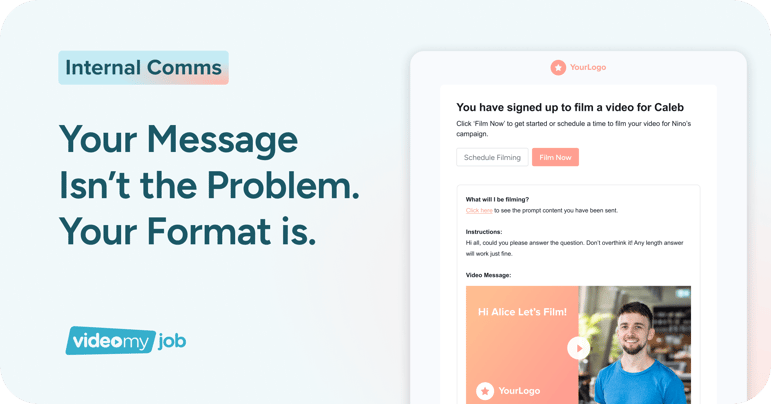Your latest company update email has a 12% open rate. The all-hands meeting attendance is dropping. Your carefully crafted intranet announcement about the new benefits package has generated precisely zero engagement. Sound familiar?
If you’re a HR or Internal Communications professional watching your engagement metrics plummet, you’re not alone. Research shows that only 23% of employees are actively engaged at work, and poor internal communication is often the culprit. But here’s the thing: it’s not necessarily your fault. Traditional internal communication strategies are failing because they’re built for a world that no longer exists.

The Modern Internal Comms Crisis
Today’s workforce is more distributed, diverse and distracted than ever before. Hybrid working has fragmented teams across time zones and locations. Gen Z employees expect Instagram-level engagement from their workplace communications. Meanwhile, information overload means your important messages are drowning in a sea of emails, Slack notifications, and meeting invites.
The old playbook of company-wide emails and quarterly town halls simply doesn’t cut it anymore. Your internal communication strategy is failing because it’s competing with TikTok for attention – and losing.
The Engagement Emergency
Let’s be honest about the state of internal comms. The average employee receives 121 emails per day. They’re bombarded with information from multiple channels, most of which feels irrelevant or impersonal. When your CEO’s quarterly update looks identical to every other corporate announcement, why would anyone engage?
This engagement crisis isn’t just about vanity metrics. Poor internal communication leads to decreased productivity, higher turnover rates and a disconnect between leadership and employees. It’s a business problem disguised as a communications challenge.
5 Campaign Ideas to Transform Your Internal Comms
1. The “Day in the Life” Deep Dive
Instead of telling employees about new policies or changes, show them through real employee stories. Create a campaign where team members from different departments share their actual experiences – the challenges they face, how they’ve adapted to changes and what’s working for them.
This approach works because it’s authentic and relatable. When Sarah from Finance explains how the new expense system actually saves her time, it carries more weight than a sterile policy announcement. These stories create emotional connections and demonstrate real-world impact.
The beauty of this campaign lies in its scalability. Once you’ve established the format, different departments can contribute their own stories, creating a continuous stream of engaging content that feels personal rather than corporate.
2. The “Behind the Scenes” Leadership Series
Transform your leadership communications from formal announcements into behind-the-scenes glimpses. Show your executives in their natural habitat – discussing challenges, making decisions and sharing their genuine thoughts about the company’s direction.
This campaign breaks down the traditional corporate hierarchy by humanising leadership. When employees see their CEO struggling with the same video call issues they face, or hear a department head admit they’re still learning about a new process, it creates relatability and trust.
The key is authenticity. Skip the polished presentations and corporate speak. Instead, capture real moments, real conversations and real insights. This approach naturally lends itself to video content, where tone of voice and body language add layers of meaning that text simply can’t convey.
3. The “Innovation Spotlight” Campaign
Rather than announcing changes after they’ve been implemented, involve employees in the innovation process. Create a campaign that showcases how ideas develop, from initial concept through to implementation.
This approach transforms internal comms from a one-way broadcast into a collaborative conversation. Employees become stakeholders in the company’s evolution rather than passive recipients of information. Share the journey of how a suggestion from the customer service team became a new feature, or how feedback from the sales floor influenced product development.
The campaign works because it demonstrates that employee voices matter. It shows transparency in decision-making and creates anticipation for future developments. Plus, it generates natural content as projects progress through different stages.
4. The “Skills Exchange” Series
Create a platform where employees can share their expertise with colleagues across the organisation. This campaign positions your workforce as the heroes of your internal communications, celebrating the diverse skills and knowledge within your company.
The format is flexible. It could be quick tips, detailed tutorials or problem-solving sessions. The key is making it peer-to-peer rather than top-down. When the marketing team shares social media best practices with HR, or when the IT department explains cybersecurity in plain English, it creates genuine value for recipients.
This campaign naturally builds community and breaks down silos between departments. It also generates content that’s inherently relevant because it’s coming from colleagues who understand the specific challenges of working at your company.
5. The “Impact Stories” Campaign
Connect day-to-day work with broader company mission and values through real impact stories. Show how individual contributions and team efforts translate into meaningful outcomes for customers, communities or the company’s goals.
This campaign works because it provides context and purpose. When employees understand how their work contributes to something bigger, engagement naturally increases. Share stories of how the support team’s empathy helped a struggling customer, or how the product team’s innovation solved a real-world problem.
The power lies in specificity and authenticity. Rather than generic statements about company values, these stories demonstrate those values in action through concrete examples that employees can relate to and feel proud of. Plus, you get the added bonus of celebrating your people’s achievements and building employee engagement through recognition.
The Video Advantage
Whilst these campaigns can work across various formats, there’s something particularly powerful about video content for internal communications. Video captures nuance, emotion and personality in ways that text and static images simply cannot. It’s also the format that modern employees are most comfortable consuming and engaging with.
Video content feels more personal and immediate. When employees see their colleagues speaking directly to them, it creates a sense of connection that’s difficult to achieve through other mediums. It’s also more accessible. Employees can watch whilst commuting, during lunch breaks or when they need a break from reading emails.
Moving Forward
The solution to your internal comms crisis isn’t more emails or better subject lines. It’s a fundamental shift towards more human, authentic and engaging communication that treats employees as individuals rather than a homogeneous audience.
These campaign ideas represent a starting point for creating internal communications that people actually want to engage with. The key is to start small, test what resonates with your audience and iterate based on real feedback and engagement metrics.
Your internal communication strategy doesn’t have to fail. With the right approach, you can transform it from a corporate necessity into a powerful tool for building culture, driving engagement and connecting your workforce with your company’s mission.
The question isn’t whether you can afford to change your internal comms strategy – it’s whether you can afford not to.
At VideoMyJob, our award-winning platform takes the leg-work (and cost) out of video production. Visit our website to see how leading employers are transforming their content strategy, from talent attraction through to internal comms.
.png?width=200&height=50&name=Untitled%20design%20(21).png)



